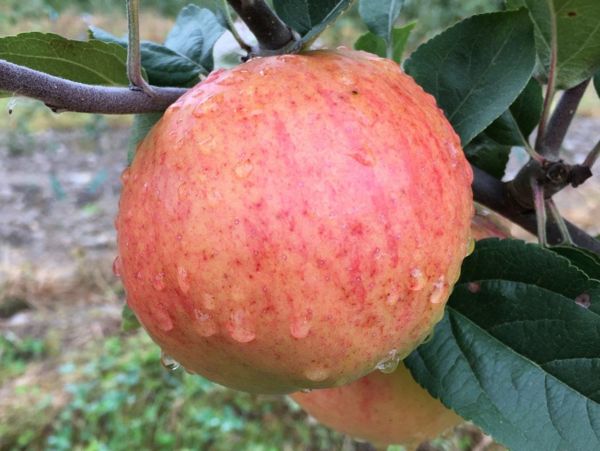An attractive, highly disease-resistant apple, ideal for organic growers.
How to Prune Stone Fruit Trees
IMPORTANT: Stonefruit should only be pruned when temperatures have reached 50°F and no precipitation is expected for the next 36 hours. We prune our peaches after bloom, before thinning. Waiting until the weather is warm and dry is an important measure for disease prevention.
Also, be careful to fully remove stubs that are not producing active growth. These will be vectors for disease. Keep a close eye on the crotch angle; this is a weak point and can also provide an entry for disease or insects. If the tree is in danger of splitting under fruit weight, the scaffolds can be bound together with strapping.
If you live in the North you will almost certainly experience years when you lose your stonefruit crop to late frosts. These fruitless years are a great opportunity to prune your trees back very hard. You can go so far as to start new scaffolds if well-positioned shoots are available as replacements. The main reason for such drastic action is because, as the tree ages, fruit buds tend to move higher and higher in the tree, leaving blind wood down low. This is your opportunity to press a reset on that drift.
First Year / Planting Year / Establishment Year
When you receive your trees, please follow the initial planting instructions. These include instructions for the heading cuts you should make directly after planting.
Second Year / First Pruning
This should be done the first spring after the tree was planted. This training method can be used for any stone fruit tree.
- Select three or four permanent scaffolds, evenly spaced around the tree, the lower the better (as long as they are above the graft union), at about 60-70° if possible. Ideally the scaffolds are not all emerging at the same height, but spaced out vertically as well as horizontally.
- Top the central leader directly above the highest scaffold. Expect a lot of vigorous growth in response to this pruning.
Third Year and Subsequent Years – All Stonefruit EXCEPT Cherries
- Remove shoots that are less than 1/4" diameter.
- Flush cut any shoots that are growing toward the center of the tree, likewise any shoots pointed downward. The end result should be a scaffold that is feathered on the sides, but not the top or bottom.
- Finally, cut about 50% of the remaining shoots back to 1-2 nodes. Choose non-fruiting shoots for this step. These cuts will produce next year’s fruiting growth.
- Ideally, your tree will have no permanent scaffolds beyond the four you originally chose. All other wood should not be older than one year.
Third Year and Subsequent Years for Cherries
Cherries should be pruned just after harvest in July, when no rainfall is expected for 36 hours. This will encourage strong, but not excessive, growth for the following fruiting year. The weather is warm and dry, which means that the wounds will heal quickly and disease is less likely to set in.
- Any branches that are droopy or on the underside of a branch, need to be removed. These are called thinning cuts.
- Cherries tend to grow vigorous upright shoots. A shoot that is very vigorous needs to be removed because it will shade out the center of the tree.
- A shoot of moderate vigor should be cut back by about a third. This will promote lateral branching and fruiting of the following year. The best fruit is on horizontal laterals about 5/16 in diameter.
Featured Products
A few things we're loving right now...
A full-flavored, freestone white peach.
A traditional semisharp cider apple from Spain.
A widely-grown, large, yellow-fleshed nectarine.












